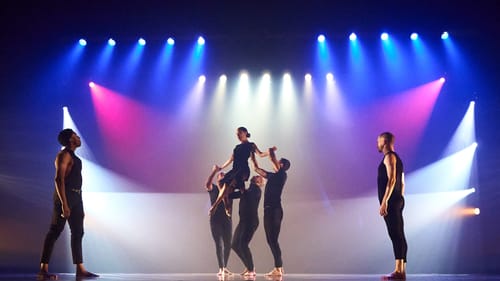Stay in the Loop
BSR publishes on a weekly schedule, with an email newsletter every Wednesday and Thursday morning. There’s no paywall, and subscribing is always free.
Reflections of Rector
Koresh Dance Company presents Muse

Koresh Dance Company’s Muse celebrates the company’s assistant artistic director and dancer, Melissa Rector. Rector has been a part of the company since its founding 30 years ago, but during a Q&A after the June 3, 2022 performance, artistic director and choreographer Ronen Koresh said that he hadn’t realized until dress rehearsal that the piece traced the story of that relationship. In fact, when another choreographer asked to borrow his muse, he didn’t realize whom he meant. For the record, the penny dropped and Koresh said, “No.”
Fittingly, the evening began by highlighting Rector’s choreography in Bang Bang, set to the Nancy Sinatra version of the song in a remix that gives it a sharp edge. The Koresh Youth Ensemble, eight young women between the ages of 13 and 18, executed a series of acrobatic moves, including handstands and flips in navy blue tulle skirts and checkered midriff tops. The dancers were exuberant, precise in some moments of unison and joyously free in others. Koresh decided on the program long before the events of recent weeks, but I could not help a frisson of dread when the dancers fell to the stage, one rising above them with arms straight and fingers pointed like a gun. “Bang, bang,” the song said, “that awful sound…”
Stillness and anger
“Muse” is an old-fashioned word with overtones of passivity, and when the curtain rose, it seemed like we might be going in that direction. Rector, in a simple black slip dress, sat alone, her arm resting on a tucked-up knee at the center of four spotlights. Mississippi John Hurt’s “I Shall Not Be Moved” played in the background, while more and more spotlights joined the others, as if the lights were their own corps of dancers. When Rector moved, her reflection glowed in the floor of the stage. Peter Jakubowski is my favorite lighting designer, and he gilded Rector’s dynamic stillness, insisting that we pay attention. Flawless.
For the most part, however, Muse reflected a contentious relationship so marked by anger and frustration that I thought it must have been created during the pandemic. But it was completed and ready to premiere when the first Covid-19 shutdowns began. Koresh choreographed the piece as 10 short dances with a score by John Levis that alternated between percussive urgency and the meditative wistfulness of keyboard and chimes, only loosely tied together by the ticking of a clock or a metronome.
Desire, passion, balance
The second dance, called “Desire,” opened with five men in black in a jazzy bit marked by hops and grunts before Rector joined the piece for a sequence of lifts by two and three and all five men. The lighting design took a starring role in “Rhythms of Humanity,” creating a cathedral of light for the whole company. Koresh designed the costumes, calf-length skirts in rich colors for the women and black pants and shirts for the men. The dance had a hint of tango, an allusion of waltz when the music slowed.

The three duets were, perhaps, the most emotionally telling, as the dancers alternately clung to each other and pushed each other away, even yelling at each other. Longtime partners Rector and Micah Geyer’s “Sweat, Love, and Tears” was sexy: Rector pushed him down, straddled him, while the urgent tick-tick-tick of time passing in the score moved to the fore.
The mood shifted markedly after the intermission. “Apparition,” (music credited to Sage DeAgro-Ruopp) had more couples parting in anger, but also a section that highlighted the women with Irish dancing—my notes compared them to Boudica, the warrior queen of the Britons. Muse ended with the joyous “Lev,” blending contemporary with Israeli folk dance, suggesting a relationship that has found its balance at last.
A muse for everyone
Even now I cannot decide how I feel about Muse. Taken piece by piece, we had strong dancing, and there is an aggressive punch to Koresh’s choreography that sets him apart. This work emphasized energy over prettiness, but he always makes you feel something, which is the purpose of art. Muse made me feel like a voyeur, though, peeping into fragments of a tumultuous relationship.
As an experiment, I set aside the stated message of the piece and instead asked myself what I thought of it in the context of the past two years rather than an artistic relationship between two people. I realized that it made more sense to me that way. During the Q&A, the dancers said that their interpretations deepened during the pandemic, and Koresh acknowledged that he started out thinking of it as The Muse, but changed the title to encompass all our muses. So I can’t help but wonder whether this piece will live in the minds of the audience as a reflection of their own troubled relationship with hard times and a well-tempered hope for the future.
What, When, Where
Muse. Choreography by Ronen Koresh and Melissa Rector. Koresh Dance Company. $35-$45. June 2-5, 2022 at the Suzanne Roberts Theatre, 480 S. Broad Street, Philadelphia. (215) 751-0959 or koreshdance.org.
The Suzanne Roberts Theatre requires proof of Covid-19 vaccination and masks inside the building.
Accessibility
The Suzanne Roberts Theatre is a wheelchair-accessible venue with assisted listening devices available for all performances. Learn more on the venue’s accessibility page.
Sign up for our newsletter
All of the week's new articles, all in one place. Sign up for the free weekly BSR newsletters, and don't miss a conversation.

 Camille Bacon-Smith
Camille Bacon-Smith